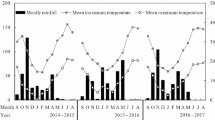Abstract
A study was conducted in Northeast Thailand on six rice paddy fields on a farm with similar soil (Aquic Quartzipsamments) and with a single tree on the paddy bund. There were 4 tree species: Parinarium anamense, Dipterocarpus obtusifolius, D. intricatus, and Samanea saman. Samples of soil (0–10 cm depth) and rice were collected at 3 positions (1, 5–7, and 9–11 m) away from the tree base in 3 replicated tree-soil trasects in each paddy field. Significantly higher pH, organic matter, and nutrients (N, P, K, Ca, and Mg) were found in paddy fields with S. saman (a legume tree) but grain yield and biomass of rice were significantly lower. Higher soil fertility was found in the positions closer to tree base while grain yields, biomass, and number of tillers were lower, and rice was taller and had more unfilled grain. Shading was deduced to be the key factor responsible for the depressed rice yields and growth at positions closer to tree base especially in the highly shading S. saman.
Similar content being viewed by others
References
Altieri MA, Trujillo FJ and Farrell J (1987) Plant-insect interactions and soil fertility relations in agroforestry systems: implications for the design of sustainable agroecosystems. In: Gholz HK, ed, Agroforestry: Realities, Possibilities and Potentials, pp 89–108. Dordrecht, The Netherlands, Nijhoff and ICRAF
Grandstaff SW, Grandstaff TB, Rathakette P, Thomas DE and Thomas JK (1986) Trees in paddy fields in Northeast Thailand. In: Marten GG, ed, Traditional Agriculture in Southeast Asia. Westview Press, 358 pp
Heckman CW (1979) Rice field ecology in Northeastern Thailand. The Hague, Dr W. Junk bv Publishers, 228 pp
Kellman M (1979) Soil enrichment by neotropical savanna trees. Journal of Ecology 67: 565–577
Medina CP (1987) Evaluation of Ipil-Ipil (Leucaena leucocephala) and Kakawate (Gliricidia sepium) as biological contour strips for productive and protective upland farming. In: Soemarwoto O, and Rambo AT, eds, Impact of Development on Human Activity Systems in Southeast Asia. Southeast Asian Universities Agroecosystem Network, Faculty of Agriculture, Khon Kaen University, Khon Kaen, Thailand
Pendleton RL (1943) Land use in Northeastern Thailand Geogr Rev 33: 15–41
Sae-Lee S (1990) Effects of trees in rice paddles on soil fertility and rice growth. An MS thesis in Soil Science, Graduate School, Khon Kaen University, Khon Kaen, Thailand, 172 pp (in Thai with English abstract)
Vityakon P, Samutkupt S and Prachaiyo B (1988) Trees in paddy fields: Their contributions to soil sustainability of the paddy rice system. In: Charoenwatana T and Rambo AT, eds), Proceedings of the SUAN IV Regional Symposium on Agroecosystem Research. Khon Kaen Univesity, Thailand
Young A (1989) Agroforestry for soil conservation. International Council for Research in Agroforestry(ICRAF), Nairobi, Kenya, 276 pp
Author information
Authors and Affiliations
Rights and permissions
About this article
Cite this article
Sae-Lee, S., Vityakon, P. & Prachaiyo, B. Effects of trees on paddy bund on soil fertility and rice growth in Northeast Thailand. Agroforest Syst 18, 213–223 (1992). https://doi.org/10.1007/BF00123318
Issue Date:
DOI: https://doi.org/10.1007/BF00123318




